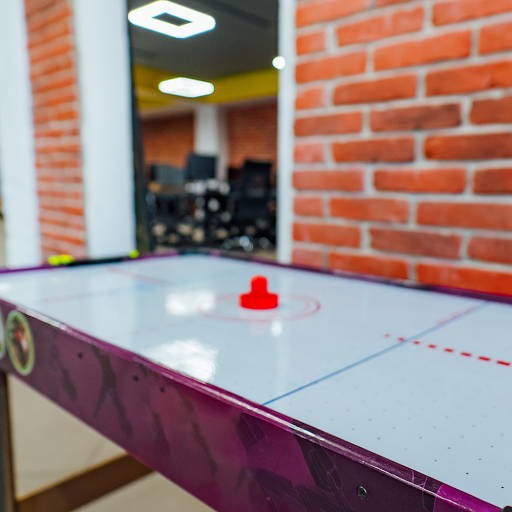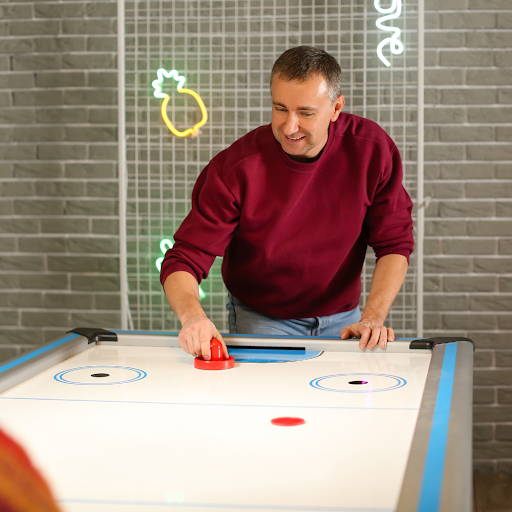Mastering Air Hockey: Strategies and Tips for Winning
Air hockey is a fast-paced, addictive game that tests your hand-eye coordination, quick thinking, and strategic planning. Whether you're playing at an arcade, a pub, or at home, a game of air hockey can be a fun and exciting way to compete with friends.
Although the game's fundamental rules are simple to grasp, developing strategies and mastering certain techniques can significantly increase your chances of winning.
Here are some expert tips to help you ace your next air hockey match.
Understanding the Basics
Firstly, let's revisit the basics. Air hockey is played on a table that blows a thin layer of air through tiny holes, reducing friction and allowing the puck to glide smoothly. Each player has a striker or mallet, and the goal is to hit the puck into the opponent's goal. The game typically ends when one player reaches a predetermined number of points, usually seven.

Key Strategies and Tips for Winning
1. Defensive Tactics:
One of the most critical aspects of air hockey is a strong defence. Here are a few defensive strategies:
Keep your mallet a bit ahead of the goal
Don't make the common mistake of keeping your mallet too far back into the goal. If it's too far back, a fast shot can ricochet off your mallet and still into the goal.
The Triangle Defence
This technique involves moving your mallet in a triangular pattern in front of your goal, making it harder for the opponent to find an opening.
React, Don't Anticipate
Instead of trying to predict where your opponent will hit the puck, focus on reacting quickly to their shots. Anticipation can often lead to over-committing, leaving your goal wide open.
2. Offensive Tactics:
While defence can keep you in the game, offense wins it. Below are some offensive strategies:
The Wrist Shot
This is a quick, snappy shot that catches your opponent off guard. Using your wrist, snap the mallet forward to strike the puck. The key is the sudden acceleration, confusing your opponent and reducing their reaction time.
The Bank Shot
Use the walls! Bank shots (or rebound shots) can be tricky to defend against. Strike the puck off the wall at an angle to make it rebound towards the goal.
Straight Shots
Straight shots are direct, fast, and often unexpected, especially if you have been using bank shots.
The Out-And-In Drift
This strategy involves moving the puck side to side in front of you before taking a shot. The continuous movement can distract your opponent and make your next move unpredictable.
3. Puck Control:
Good puck control can give you more shot options and make it harder for your opponent to gain possession.
The Overhand Grip
Some players find they have more control over the mallet when they use an overhand grip. Experiment with different grips to see what works best for you.
The Weave Drift
This technique involves moving the puck in a weave pattern, making your offense more unpredictable.
4. Practice:
As with any game, practice is key in air hockey. Try to practice different shots, grips, and strategies to see what works best for you.

Taking the Game to the Next Level
Remember, air hockey is a game of speed, agility, and strategy. It's not just about striking the puck; it's about how and when you strike it. A well-timed, well-placed shot can make all the difference.
Advanced Strategies and Tips
Let's delve into a few more advanced strategies and tips that can help you sharpen your air hockey skills and add new dimensions to your gameplay.
1. Mallet Handling Techniques:
Let's delve into a few more advanced strategies and tips that can help you sharpen your air hockey skills and add new dimensions to your gameplay.
Standard Grip
Most beginners start by gripping the knob of the mallet from above. This grip provides good overall control and can facilitate both offensive and defensive play.
Finger Grip
Some players prefer to place their fingers on the playing surface with the knob of the mallet tucked between the index and middle fingers. This grip can provide better manoeuvrability and quick response for defensive play but may be less powerful for offensive shots.
2. Trick Shots:
As you become more comfortable with the game, you might want to experiment with trick shots.
Double Bank Shot
This shot involves hitting the puck to the side rail first, then hitting the end rail before heading toward the goal. It's a tricky shot to defend against and can catch your opponent off guard.
Under-the-Mallet Shot
This deceptive shot involves pulling the puck back as if to shoot to one side, then hitting it under the mallet to the other side. It can be highly effective if your opponent tends to commit to a side early.
3. Mind Games:
At higher levels of play, air hockey involves psychological strategies as well.
Changing Pace
Constantly varying the speed and rhythm of your shots can throw your opponent off balance.
Body Language Deception
Using your body language to deceive your opponent can be an effective strategy. For instance, leaning to one side as if to shoot there, then hitting the puck to the other side.
Pausing
An unexpected pause before shooting can break your opponent's rhythm and concentration, setting you up for a successful shot.
4. Staying Fit:
Air hockey is a physically demanding game that requires quick reflexes, a steady hand, and good upper body strength. Regular physical exercise, including cardio and strength training, can help improve your stamina and agility, giving you an edge over your opponents.

Remember, air hockey is not only about physical prowess but also mental sharpness. Keep practicing, stay focused, enjoy the game, and with time, you'll find yourself becoming a formidable air hockey player.
So get out there, keep practicing, and enjoy every match!
Are you looking for an Air Hockey table? check out our air hockey range here Air Hockey tables





